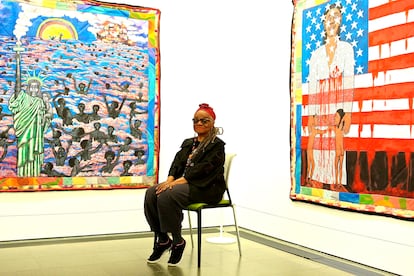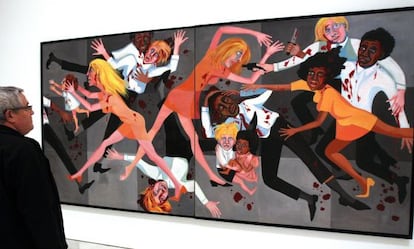Must a woman turn 93 before her artistic achievements are recognized?
Even after a remarkable career in art, Faith Ringgold hadn’t been the subject of a retrospective until just shy of her centennial. It will take decades to achieve equal representation of women’s work in museums

The first retrospective of the African-American artist Faith Ringgold (Harlem, 1930) in Chicago opened on November 18 in the Museum of Contemporary Art (MCA). It forms part of the MCA’s Women Artists Initiative, which since 2015 has put $1 million annually toward the acquisition of work made by women, in search of achieving gender equity in the museum. It is also one of the first bilingual exhibitions, another of the museum’s strategies to be more inclusive of the Spanish-speaking community. However, although the recognition of the magnitude of the artistic trajectory of Ringgold symbolizes the re-equilibration of the artistic canon, it does raise many questions: the retrospective is also the artist’s first solo show in the city. Why now, after 60 years of career and when she is 93 years old?
As the daughter of a fashion designer, Ringgold first made a name for herself through the quilts that she began stitching with her mother. They told stories, denounced injustices. Their titles said it all — Slave Rape 1 and The Flag is Bleeding. The tale of Ringgold is that of a Black female artist trying to find her place in a supremacist, patriarchal society led by white men. The artist, who has 16 honorary degrees, has been key in the raising of awareness around the need to create a more inclusive society. During the 1960s, she actively participated in the Civil Rights Movement, founding various feminist and anti-racist organizations. She protested Angela Davis’s incarceration and curated an exhibition against the war in Vietnam. Her best-known series, American People, which shares its title with the retrospective, highlights the racial tension that erupted in the United States with the Black Panthers and that remains in force, revindicated by Black Lives Matter.
Despite the relevance of her work, and having stayed present and prolific throughout more than a half century, it wasn’t until 2017 that one of the most important museums in the world, the Tate Modern in London, included her in a collective exhibition about Black art. From then on major cultural institutions began to show interest in her career path. In 2019 her mural Die, inspired by Guernica, was hung in the MoMA alongside Picasso’s Les Demoiselles d’Avignon, baptizing it as one of the main attractions of the museum. And in 2022, Time magazine recognized Ringgold as one of its 100 most influential people in the world, suddenly crowning her as one of the great artists of our era.

The history of art is full of women who were recognized late, like Cecilia Vicuña and Carmen Herrera, who sold her first painting when she was 89 years old. According to an article by the journalist Jillian Steinhauer in the magazine Believer, the best way to achieve success as a female artist is to be younger than 70, be courting death, and have spent one’s life creating work that has only recently been shown. “You’re a safe bet at the same time as you’re a discovery.”
According to the 2022 Burns Halperin report, which explores representation in the art industry over the last 12 years, in 2019 the average of acquired works made by women in U.S. museums represented a mere 11%. “It’s like we’re crabs: if one or two of us gets out of the bucket, it feels so exciting. But what are we cheering? We should be protesting!” artist Mickalene Thomas told Artnet, a website dedicated to the art market.
But how can we prevent artists from having such belated recognition? In the case of the MCA, a Chicago museum primarily led by women, Madeleine Grynsztejn, its director, explains that to arrive at an egalitarian representation institutions “have to profoundly, intentionally and structurally commit to the goal, not because of fashion or esthetics”. And, she adds emphatically: “The commitment is evidenced not only in temporary exhibitions, but in permanent collections and publications. The commitment has an much higher economic cost, but it is ethically imperative.” In the 15 years that she has helmed the MCA, results have begun to stand out: it has been the museum that has bought the most amount of works from artists who have been historically overlooked. They have doubled the national average, acquiring 25% works by women and have quadrupled another average by obtaining 10% works by African-American artists. Jamillah James, curator of the Ringgold exhibition, says during a guided visit of the show that “it is fundamental that institutions hire curators who guarantee the diversity of artists who are shown and who help the public to see the world in a different way”.
María Ángeles López Fernández-Cao, dean of fine arts at the Complutense University of Madrid, says that in the art industry there must be “effective democracy and real equality.” And to that end, she highlights the world of the MAV (Women in Visual Arts) association, which has been denouncing masculine overrepresentation in the Spanish art industry for decades, despite the fact that 70% of students in academia are women. She also underlines the need to revise the books, texts and manuals of art history that have been written throughout the years. “When a young person doesn’t see anyone besides Western male artists as representatives of creativity, they are not only receiving a distorted, false vision of the past, they are also receiving the legitimization of a Western and masculine superiority in terms of creativity. That is what we call epistemological blindness and cognitive injustice. And it’s very serious,” she says. “One example was the expulsion from the Spanish cultural genealogy of the entire feminist intellectual generation of ‘27, with Maruja Mallo at its head, which impacted the symbolic construction of our society.”
According to López Fernández-Cao, this accepted belief that only the actions of Western men are valuable and the rest may be forgotten contributes to a symbolic violence that gives birth to real delegitimization. If we keep on like this “we are hierarchizing the human race. Because of that, many museums are making a profound review of their philosophy and budgets, and are changing the paradigms.”
The central problem lies in the artistic canon, which defines the norms and values of historic recognition. Constanza Tobío, dean of sociology at the Carlos III University in Madrid, highlights the fact that even if the work of women becomes widely known while they are still alive, they are forgotten once they die. “That’s how it happened with Artemisia Gentileschi, Lavinia Fontana, Francesca Caccini, Barbara Strozzi and Marie de Gournay, among so many others.” This is seconded by López Fernández Cao: “When these brilliant careers become written history, they are adapted into the patriarchal canon and erased from the isms and the artistic genealogies exclusive to Western men and created by Western men.”
The key is in a historical review and an objective and inclusive cultural programming that allows for a spacious point of view that is more representative in terms of movements, works, and artists. Like Jamillah James says, “artistic institutions are headed in the right direction,” but it will take decades, even centuries, to achieve just representation.
Will Faith Ringgold be taught in art history books?
Sign up for our weekly newsletter to get more English-language news coverage from EL PAÍS USA Edition
Tu suscripción se está usando en otro dispositivo
¿Quieres añadir otro usuario a tu suscripción?
Si continúas leyendo en este dispositivo, no se podrá leer en el otro.
FlechaTu suscripción se está usando en otro dispositivo y solo puedes acceder a EL PAÍS desde un dispositivo a la vez.
Si quieres compartir tu cuenta, cambia tu suscripción a la modalidad Premium, así podrás añadir otro usuario. Cada uno accederá con su propia cuenta de email, lo que os permitirá personalizar vuestra experiencia en EL PAÍS.
¿Tienes una suscripción de empresa? Accede aquí para contratar más cuentas.
En el caso de no saber quién está usando tu cuenta, te recomendamos cambiar tu contraseña aquí.
Si decides continuar compartiendo tu cuenta, este mensaje se mostrará en tu dispositivo y en el de la otra persona que está usando tu cuenta de forma indefinida, afectando a tu experiencia de lectura. Puedes consultar aquí los términos y condiciones de la suscripción digital.
More information
Archived In
Últimas noticias
Most viewed
- Oona Chaplin: ‘I told James Cameron that I was living in a treehouse and starting a permaculture project with a friend’
- Sinaloa Cartel war is taking its toll on Los Chapitos
- Reinhard Genzel, Nobel laureate in physics: ‘One-minute videos will never give you the truth’
- Why the price of coffee has skyrocketed: from Brazilian plantations to specialty coffee houses
- Silver prices are going crazy: This is what’s fueling the rally










































